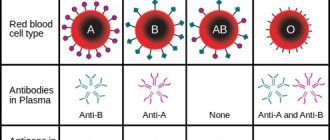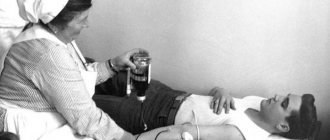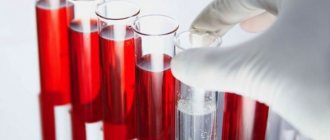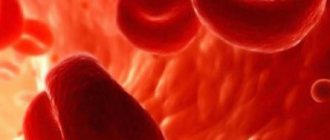In the clinical practice of doctors, sometimes the following situations occur: a person experiences frequent bleeding, or, conversely, blood clots form excessively in his body, which leads to thrombosis of large veins.
Many elements of the large chain of the coagulation system are responsible for the smooth functioning of the blood coagulation system. Fibrinogen is one of the elements of this chain: without this protein, the correct functioning of the homeostatic link is impossible. Doctors often prescribe determination of the level of fibrinogen in the blood to determine the state of a person’s coagulation system.
Fibrinogen - what is it?
Fibrinogen is a protein of the blood coagulation system, which is renewed by the liver regularly over 3-5 days. The moment the blood coagulation system in the plasma is activated, thrombin (another important element of the blood coagulation system) activates the conversion of fibrinogen to fibrin, which is essential for the formation of a blood clot. Fibrinogen is a protein monomer, and fibrin is a polymer, that is, a protein chain that is the basis for the formation of a blood clot.
The normal level of fibrinogen in human blood is 2-4 mg/l. If the value decreases, then the person is prohibited from surgical interventions - there is a high risk of bleeding. If fibrinogen is elevated , then there is a high probability of vascular thrombosis in patients, especially the formation of blood clots in the deep veins of the lower extremities. Deep vein thrombosis carries a high risk of a fatal complication called pulmonary embolism.
The protein level must be checked before surgical interventions, before planned childbirth, and in case of pathologies of the hepatobiliary system. It is especially important to determine the concentration of fibrinogen in patients with diseases of the heart and blood vessels; suffering from increased thrombosis, or, conversely, bleeding.
What does fibrinogen mean for the human body ? Protein performs a number of important functions:
- directly participates in thrombus formation, being a substrate for the formation of fibrin, which forms the basis of a blood clot;
- directly affects the rate of stopping bleeding and healing of open wounds in humans;
- regulates the processes of dissolution of fibrin clots (fibrinolysis) after the damaged areas have been restored;
- actively participates in the process of building a new vascular network (angiogenesis), as well as in the interaction between individual cells;
- affects the composition of the blood, as well as the structure of the wall of arterial vessels during an active inflammatory process;
- participates in regenerative reactions when the patient’s skin or mucous membranes are damaged;
- participates in increasing the strength of the vascular wall, which limits the inflammatory focus and prevents the spread of pathological microorganisms through the bloodstream.
If, when determining the norm of fibrinogen in the human body, it was discovered that the protein is elevated, then, most likely, the body is in an active stage of fighting the inflammatory process. Often this also increases the erythrocyte sedimentation rate, as well as a special diagnostic marker of inflammation and tissue necrosis. If fibrinogen is elevated in a pregnant woman, then this is considered a variant of the norm: during gestation, the functioning of many systems of the woman’s body, in particular the blood coagulation system, changes slightly.
In elderly patients, an increase in fibrinogen is dangerous: the doctor should be wary of the increased risk of developing heart and vascular disease.
What happens to the body during the 1st trimester of pregnancy
The 1st trimester is considered from the moment of conception to 12 weeks of pregnancy.
Direct fertilization of the egg occurs in the abdominal cavity. After fertilization, the egg is located in the abdominal cavity and is actively fragmented into smaller cells and becomes similar to a raspberry or mulberry, such an embryo is called a morula. It is then captured by the villi of the fallopian tubes and moves into the uterine cavity. On the 7th day, the embryo attaches to the wall of the uterus. The fertilized egg begins to form, consisting of amniotic fluid and the yolk sac, from which the embryo will form. At 7-8 weeks, a fertilized sac and placenta are formed from the fertilized egg. From 8 to 12 weeks the placenta is finally formed (later on it only develops), it becomes visible on ultrasound. At week 12, the embryo looks like a full-fledged child measuring about 9 cm, its limbs, head and main internal organs are formed.
Mother's changes. Ideally, a woman does not feel pregnancy at all. The only sign is an enlargement of the mammary glands, due to the development of glandular tissue under the influence of hormones. The belly practically does not increase.
During pregnancy, many women experience so-called “toxicosis” - nausea and/or vomiting. This is due to an increase in the level of estrogen (in particular progesterone) and hCG (chronic gonadotropin). Moreover, these symptoms can complicate the life of a pregnant woman not only in the morning, but at any time of the day. Sometimes nausea or vomiting may persist throughout pregnancy.
There is such a serious complication as excessive (uncontrollable) vomiting in pregnant women, which leads to dehydration of the mother, disruption of the body's electrolyte balance, disruption of the liver and kidneys and encephalopathy, requiring hospitalization and treatment in a hospital.
It is best to eat according to your appetite. Food should not cause negative reactions, eat in small portions, pay attention to what food provokes nausea and try not to eat it for a while, listen to your body, usually the woman herself feels what she would like to eat. Don't forget that food should not only be desirable and tasty, but also healthy. It would be ideal to eat according to the “Harvard Healthy Eating Plate” method, when ½ of the plate’s volume is occupied by vegetables, ¼ by proteins (including plant-based), ¼ by complex carbohydrates (grains, potatoes, cereals, etc.).
Your body will also begin to change. And the first thing you will feel will be engorgement and increased sensitivity of the mammary glands, the nipples will swell a little and increase in size. It is important to wear comfortable, comfortable underwear and clothing to minimize discomfort. Sometimes there is pain in the nipples; your gynecologist may recommend ointments for this case.
We all remember that a pregnant woman becomes more vulnerable, whiny and even sometimes capricious. This is also associated with an increase in estrogen levels and requires patience and understanding on the part of family and partners. A calm environment at home and, if possible, at work is important. You can use relaxation methods such as walking, listening to your favorite music, aromatherapy if there are no reactions to odors. Think about what could bring back balance and calm to you?
The main pregnancy hormone, progesterone, causes fluid retention in the body. At the same time, the growing uterus puts pressure on the bladder and a frequent urge to urinate appears. This is normal, it is important to plan your day so that you always have the opportunity to visit the toilet.
Progesterone also reduces the tone of blood vessels, which can lead to dizziness. You can minimize these unpleasant sensations by changing your body position smoothly; do not stand up or sit down abruptly. Another reason for frequent dizziness may be a decrease in the level of magnesium in the blood; your doctor will help you figure this out.
Pregnant women often have an increased need for sleep, which is explained by the same effect of hormones, as well as the need for additional rest for the body, because there is a lot of work to carry, give birth and then feed the baby.
Under the influence of progesterone, the smooth muscles of the entire body relax (uterus, intestines, blood vessels, bile ducts and pancreatic ducts, etc.), the work of internal organs slows down, which in turn leads to constipation and heartburn. In addition to medication correction (prescribed by a doctor), split meals in small portions, foods rich in fiber (our favorite vegetables), sufficient fluid intake, feasible physical activity (physical therapy, walking, swimming, yoga, Pilates, etc.) help.
Unfortunately, sometimes pregnancy is overshadowed by pathology; let's talk about the most common problems in the first trimester of pregnancy.
When is the study scheduled?
Doctors prescribe determination of fibrinogen in the blood
- if the patient had massive bleeding or an episode of thrombosis;
- to assess other indicators of blood coagulation, which are determined during a blood test for a coagulogram;
- if progression of liver disease is suspected, because fibrinogen is synthesized in this organ;
- if the patient is suspected of having hemophilia or other pathologies of the blood coagulation system;
- in the preoperative period to ensure that surgical intervention can be performed;
- in the recovery period after surgery to assess the intensity of wound healing and inflammation activity;
- in case of pathology in the functioning of the cardiovascular system;
- in the presence of an active inflammatory process that develops for an unknown reason.
The fibrinogen norm in women is especially important to determine during pregnancy. A pregnant woman should be tested for fibrinogen once every trimester so that the doctor can prevent the development of complications in time.
Causes of deviations in coagulogram
During gestation, there is a risk of developing disseminated intravascular coagulation syndrome, the first stage of which is characterized by hypercoagulation, and the second by hypocoagulation (increased and decreased blood clotting, respectively) and is dangerous with massive bleeding.
The development of DIC syndrome is caused by blood clotting disorders that occur in the following situations:
- gestosis;
- premature placental abruption;
- placenta previa;
- amniotic fluid embolism;
- arterial hypertension;
- liver diseases;
- antiphospholipid syndrome;
- threat of miscarriage (infections, hormonal imbalance);
- Rhesus conflict pregnancy;
- antenatal fetal death;
- hemorrhagic shock;
- chronic extragenital diseases of the mother (kidney disease, diabetes mellitus, systemic diseases).
What is the research used for?
Doctors use diagnostics for:
- assessing the body's ability to form blood clots;
- confirmation of the presence of diseases of the coagulation system, in particular those of a hereditary nature;
- diagnosis of liver diseases;
- detection of active inflammatory process;
- assessing the degree of exhaustion of the body.
Doctors also determine the level of fibrinogen in the blood
The study is actively used at the preoperative stage, as well as when the patient is suspected of having inflammatory diseases. Interestingly, fibrinogen is known as one of the blood factors used in “rheumatic tests”. It has long been proven that a significant deviation from the norm of fibrinogen is observed in rheumatic, autoimmune processes, as well as in tissue damage.
Disorders of vascular-platelet hemostasis
Disturbances in this part of hemostasis most often manifest themselves as increased bleeding, a tendency to form hematomas (bruises) with the slightest contact, or even spontaneously, for no apparent reason. In some situations, on the contrary, there is a tendency to excessively easy thrombosis.
There are factors that stimulate the formation of a primary thrombus and those that disrupt it. Stimulants include the inflammatory process, because inflammation increases the content of biologically active substances in the blood. We can say that there is a readiness for the formation of a blood clot; it is only a matter of local damage to the vessel. Therefore, in severe infectious diseases, blockage of blood vessels may occur. There is an increased readiness for thrombosis during pregnancy, as well as in some hereditary diseases (thrombophilia). Among food products, table vinegar (marinades) and coffee increase platelet activity.
The process of formation of a primary thrombus is disrupted when the number of platelets decreases (thrombocytopenia) and when there is a qualitative deficiency of platelets (thrombocytopathy). Thrombocytopathy can occur when taking certain medications. First of all, these are anti-inflammatory drugs: aspirin, analgin, brufen, some antibiotics. Thrombocytopathy also develops in kidney diseases. Spices and strong alcohol can also reduce the usefulness of platelets.
The blood coagulation system is actually several interconnected reactions occurring in the form of a cascade, or chain reaction. At each stage of this process, the proenzyme (the inactive form of the enzyme) is activated. Thirteen of these proteins (clotting factors) make up the coagulation system. They are usually designated by Roman numerals from I to XIII.
Method of determination
As a rule, fibrinogen in the blood is determined when venous blood is taken from a patient for a biochemical study or coagulogram.
Determining the level of fibrinogen in the blood is a rather complex procedure. There are many methods for assessing the amount of this protein in blood serum. The most common way to determine the clotting time of citrated plasma in the laboratory is to use excess thrombin. A special calibration curve is used to estimate fibrinogen concentration.
Fibrinogen norm
The fibrinogen standard taken as a basis was discovered through clinical studies of various groups of people.
Table 1. Fibrinogen levels in different groups of patients
| Patient group | Fibrinogen norm, g/l |
| Adult men and women | 2—4 |
| Pregnant women (highest value for 3rd trimester) | 6—7 |
| Newborn babies | 1,25—3 |
Regulation of fibrinogen concentration in the blood depends on many different factors. Protein levels are affected by gender, age, general condition of the body and human activity.
The average fibrinogen value for the population as a whole is considered to be the norm: researchers diagnosed healthy patients from each specified category, and then determined the average fibrinogen value for a healthy person.
Deciphering the fibrinogen test
The interpretation of the analysis is carried out by the attending physician who prescribed the diagnosis to the patient (therapist, cardiologist, hematologist, surgeon or other specialist).
Fibrinogen is a protein, the increase of which indicates that a person is undergoing an acute phase of the inflammatory process. If fibinogen is elevated in a patient (above 4 g/l), then the doctor may suspect tissue damage inside the body or the presence of active inflammation. At the same time, the reason for the increase in fibrinogen has yet to be determined: the protein is only a marker of inflammation. Often, an increase in fibrinogen levels significantly increases the risk of complications of cardiovascular diseases, if the patient has them.
Sometimes fibrinogen in the blood is low (below 2 g/l), which can result from a blood transfusion to a person. In addition, some medications can reduce the level of fibrinogen in the blood - for example, anabolic steroids, urokinase, streptokinase.
Sometimes, after testing for fibrinogen, a person is found to have dysfibrinohemia. This is a hereditary disorder in which mutations occur at the gene level: the production of fibrinogen in the liver is disrupted. Often the pathology leads to the active formation of venous blood clots, rarely to bleeding. Depending on the clinical picture, the doctor will offer the patient options for treating dysfibrinogemia.
Finally, studies have been conducted that have shown that active use of medications containing certain fatty acids (omega-3, omega-6) has a negative effect on fibrinogen levels. Protein may decrease while taking these drugs.
Only the attending physician can tell the patient about the specific reasons for the increase or decrease in fibrinogen levels. After collecting complaints, medical history data, examining the patient and performing additional diagnostic methods, the doctor will have a complete picture of the person’s health status.
Then the doctor will propose a treatment regimen, therapy tactics, and will observe the patient over time.
What is fibrinogen in a blood test?
Fibrinogen is a dissolved protein component circulating in the bloodstream that plays a key role in the formation of blood clots. The function of producing a substance that is renewed every 3-5 days lies with the liver cells.
The compound is involved in the initial stage of blood clot formation, being cleaved by thrombin to thread-like fibrin. Protein strands form a framework at the border of the injury, to which blood cells adhere, forming a blood clot. The resulting solid clot closes the wound and stops further bleeding. In addition to the hemostatic function, the protein compound is involved in:
- accelerating the regeneration of damaged areas of the skin, mucous membranes, soft tissues;
- fibrinolysis - the process of dissolving a blood clot as damaged areas are restored to normalize blood supply and prevent embolism;
- angiogenesis – the process of vascular growth;
- strengthening the walls of blood vessels to limit foci of inflammation and prevent further spread of pathogenic microorganisms.
Participation in many processes makes the amount of circulating protein within normal limits extremely important for the normal functioning of the body.
What does fibrinogen show in the blood?
Accurate assessment of test results is of particular importance due to the tasks assigned to fibrinogen. Calculating the concentration of a protein compound helps in diagnosing many diseases, as it directly controls blood clotting processes, thereby maintaining hemostasis. A shift in normal protein levels in any direction leads to severe deterioration in health, even threatening life.
How to take a fibrinogen test?
To measure the level of protein compounds, you need to do a coagulogram or biochemical analysis of the blood composition. In both cases, a small amount of venous blood is used. To get the correct result, the procedure must be performed on an empty stomach, waiting at least 10-12 hours after the last meal.
Also, 2-3 days before the test, it is worth eliminating fatty, fried, smoked foods and alcohol from the diet, reducing physical activity, organizing a normal rest schedule and protecting yourself from emotional stress. The last cigarette can be smoked at least half an hour before the test.
With the permission of the doctor, you should also temporarily stop taking medications that affect plasma coagulation or liver protein synthesis.
Fibrinogen during pregnancy
Obstetricians and gynecologists should carefully monitor fibrinogen levels in women during pregnancy. In the first trimester, the level should be 2.98 g/l. There may be a slight decrease in the level of fibrinogen in the blood in the first trimester, which is associated with toxicosis.
In the second trimester, an increase in fibrinogen levels is observed, usually up to 3.1 g/l. In the third trimester, the protein concentration is significantly increased and amounts to 4.95-6 g/l.
Timely monitoring of fibrinogen levels in women during pregnancy can prevent the following pathological conditions of the mother or child:
- spontaneous abortion, frozen pregnancy and further infertility;
- premature detachment of a normally located placenta;
- thrombosis of umbilical cord vessels;
- gestosis;
- premature birth;
- thrombophlebitis or deep vein thrombosis of the extremities in the mother.
A pregnant woman, as a rule, undergoes a coagulogram (analysis for the full range of enzymes of the blood coagulation system) several times during the entire gestation period.
An analysis of fibrinogen levels performed in the early stages of pregnancy indicates the primary levels of fibrinogen in the mother's body. Diagnosis during pregnancy shows the progress of gestation, and analysis immediately before birth will indicate the risks of thrombosis and show the mother’s body’s readiness for the birth process.
Fibrinogen is reduced
A decrease in the concentration of fibrinogen in the blood leads to a significant decrease in the blood's ability to clot. This means that any minor injury can lead to prolonged bleeding. Doctors identify both congenital and acquired causes of decreased fibrinogen levels.
The main reasons for decreased fibrinogen levels include:
- a history of massive blood loss that occurred recently;
- disseminated intravascular coagulation syndrome - in the presence of this pathology, a large number of microthrombi form in a person’s blood;
- development of severe liver diseases (for example, cirrhosis or hepatitis);
- during pregnancy: fibrinogen decreases due to early or late toxicosis;
- lack of vitamins C and B12;
- congenital diseases that can be transmitted hereditarily (for example, afibrinogenemia);
- oncological diseases - chronic myeloid leukemia;
- poisoning with toxic substances (or bites of poisonous animals whose saliva contains poison - for example, snakes);
- decrease while taking anticoagulants (drugs that reduce blood clotting) - urokinase, streptokinase;
- in newborns, the cause may be amniotic fluid embolism - the entry of amniotic fluid into the bloodstream of a newborn baby;
- polycythemia;
- decrease in fibrinogen concentration while taking anabolic steroids and androgens;
- while taking antioxidant drugs (vitamin E);
- due to alcohol consumption.
Sometimes patients' fibrinogen levels decrease due to active consumption of fish oil. This is probably due to the high content of fatty acids in this product - omega-3 and omega-6. Reduced protein levels are sometimes observed in vegetarians. It is important to remember that a decrease in fibrinogen concentration to less than 0.5-1 g/l significantly increases the risk of bleeding from internal organs.
If fibrinogen is reduced, the doctor needs to determine the reasons for the deviation from the norm. In order not to waste time, the doctor can prescribe drugs that artificially promote the formation of blood clots: aminocaproic acid, dicinone, vikasol. At the same time, the attending physician recommends that the patient adjust the diet and add protein-rich foods (eggs, meat, legumes) to daily meals.
Fibrinogen is increased
If fibrinogen is elevated, then we can say that the patient’s homeostasis system was activated by some factor: for this reason, there was a need for excessive blood clot formation. This often occurs against the background of an active inflammatory process in a person.
Fibrinogen in the blood increases due to the following conditions:
- while taking oral contraception;
- for autoimmune diseases - if a person suffers from rheumatism, amyloidosis.
- with pathology of the heart and blood vessels: against the background of myocardial infarction;
- due to the development of kidney diseases - with nephrotic syndrome;
- in the presence of infectious diseases;
- against the background of diabetes mellitus;
- for diseases of the respiratory system - pneumonia, tuberculosis;
- in initial forms of liver disease - hepatitis;
- at the first stage of development of DIC syndrome;
- if a person has cancer;
- severe patient conditions - massive injuries or significant burns;
- in the postoperative period;
- if the patient has hypothyroidism (decreased amount of thyroid hormones in the blood serum);
- the first 24 hours after a stroke in a person;
- if the patient has vascular pathology (atherosclerosis, varicose veins, thrombophlebitis).
It should be remembered that a physiological increase in fibrinogen is observed in women during pregnancy. The maximum protein concentration can reach 7 g/l. Fibrinogen is often elevated in patients with high body mass index.
To correct the condition, the doctor determines the reason for the deviation of the patient’s fibrinogen indicator from the norm, and then prescribes the necessary treatment regimen.
Antiplatelet agents and anticoagulants, thrombolytics and fibrinolytics are often used to correct fibrinogen levels. These groups of drugs are prescribed exclusively by the attending physician, because they must be taken under the supervision of a specialist.
As is the case with a decrease in fibrinogen, the doctor recommends that the patient review the diet: add more seafood, fish, red berries, cocoa and dark dark chocolate.
What to do if there is elevated fibrinogen?
If the analysis shows that the coagulation factor in the blood exceeds the permissible norm, you should consult a doctor for a more detailed examination and identify the cause of the increase. The specialist’s task in this case is to prescribe effective therapy to eliminate the underlying disease. Eliminating the root cause of the increase in the amount of protein leads to its gradual independent reduction to acceptable limits.
If necessary, fibrinogen levels can be normalized:
- antiplatelet agents;
- anticoagulants;
- thrombolytics;
- fibrinolytics.
A revision of the diet with the inclusion of fresh vegetables, seafood and fish, red berries, dark chocolate or cocoa has a beneficial effect on the amount of protein compounds in the blood. If you follow your doctor's instructions, elevated fibrinogen does not pose a serious health hazard.
Preparing for analysis
Fibrinogen levels are assessed when the patient submits a classic biochemical blood test or a blood coagulogram. In this case, venous blood is collected from a person in the laboratory. To obtain the correct result, several rules must be strictly followed before the study.
It is forbidden to eat food 10-12 hours before blood sampling, that is, you must come for the study on an empty stomach. 2-3 days before diagnosis, you should avoid fatty and fried foods and alcohol. If you are actively involved in physical activity, then before the study it is necessary to reduce the amount of exercise. Smoking is allowed only 40 minutes before blood sampling.
Before scheduling a test, you should discuss with your doctor the medications you take regularly. You may have to stop taking medications for a while to get the correct result.
Preparation before taking the test
For the study, venous blood is collected in the morning, on an empty stomach; it is advisable not to eat anything 12 hours before collecting biological material. You can also take the test throughout the day, provided you fast for 2-4 hours before the procedure. 2 hours before it, you should give up intense physical activity and smoking. Fibrinogen levels in the blood can be affected by certain drugs and medications, for example, heparin, anabolic steroids, androgens, antioxidants and oral contraceptives.
Avoid taking a fibrinogen hormone test during treatment for infectious diseases and severe bleeding, as well as for 1 month after a blood transfusion.
Fibrinogen in children
In childhood (up to 18 years), the level of fibrinogen in the blood is slightly different from “adult” levels. Regardless of gender, the normal level of fibrinogen in children is considered to be 1.25-4 g/l. The exception to this group are newborn children, whose fibrinogen value ranges from 1.25 to 3 g/l.
The fibrinogen indicator in children differs from “adult” values because in childhood the homeostasis system is still being formed, like many other systems of the body. Over time, the child’s fibrinogen level approaches “adult” levels.
As you can see, the answer to the question about the importance of fibrinogen for the human body is far from clear-cut, as expected. The level of fibrinogen in human blood depends on many factors, and an increase or decrease in its concentration often becomes the most important marker of the inflammatory process. A laboratory symptom of an increase or decrease in protein is a clear marker that will allow the doctor to suspect certain pathologies in the patient. Doctors actively use fibrinogen testing to assess patients’ homeostasis system, prescribe a treatment regimen and monitor the dynamics of patient therapy.











